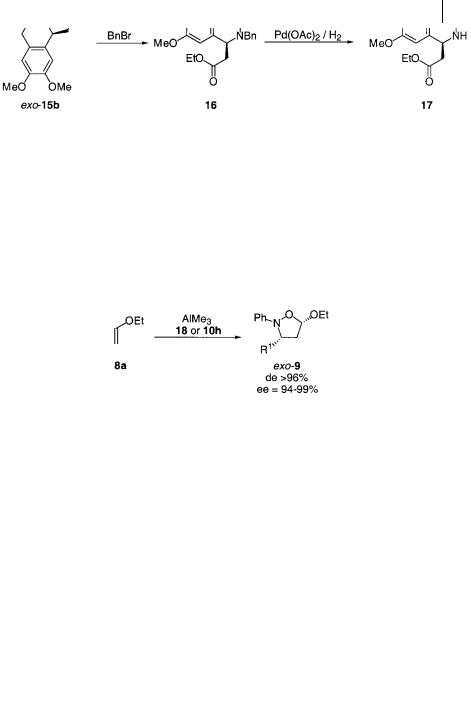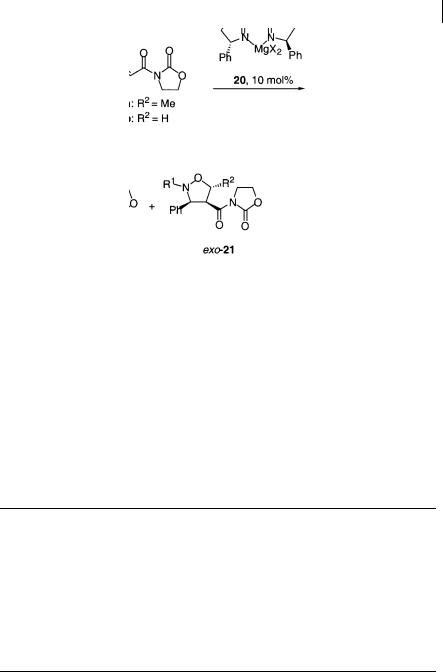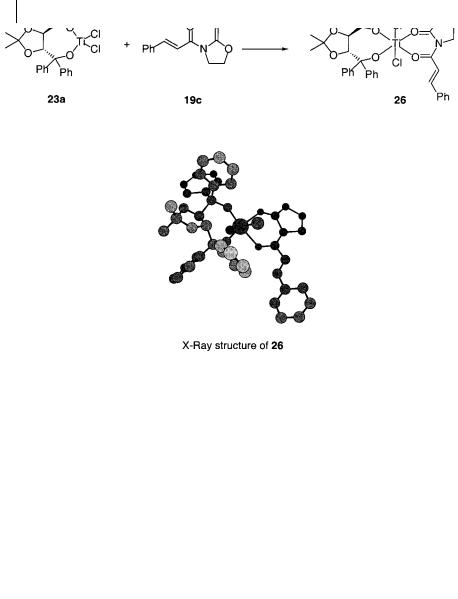
Cycloaddition Reactions in Organic Synthesis
.pdf
220 6 Asymmetric Metal-catalyzed 1,3-Dipolar Cycloaddition Reactions
1999 [23]. The initial catalytic experiments were performed using the AlMe-BI- NOL catalyst 11a, that was simply synthesized by mixing the chiral ligand 1,1-bi- naphthol (BINOL) 10a with AlMe3 (Scheme 6.11). This catalyst was applied for the reaction between nitrone 1a and vinyl ether 8b. A large rate enhancement was observed by using this catalyst, however, the selectivity of the reaction was rather disappointing. An exo/endo ratio of 73 : 27 was obtained and the exo product was formed with a low ee of < 5%. As a part of these studies a new method for the synthesis of 3,3 -aryl-substituted BINOL ligands 10b–f was developed [33]. The introduction of substituents on the ligands 3,3 -position as in catalysts 11b–f led to a remarkable improvement of the selectivities when these catalysts were applied in the reaction of 1a with 8b (Scheme 6.11). Especially, complex 11b possessed the desired properties as the reaction performed in the presence 20 mol% of this catalyst was completed to give exo-9b as the only observable diastereomer and the enantioselectivity of this product was 89% ee.
Scheme 6.11
Further improvement of the reaction was achieved by applying ethyl vinyl ether 8a in the reaction instead of 8b (Scheme 6.12). The reactions between a series of nitrones 1a–d with 8a catalyzed by 10 mol% of 11b all proceeded to give the corresponding products 9 with excellent exo selectivity and with enantioselectivity of 88–97% ee in all cases [23].
A model for the mechanism of the highly enantioselective AlMe-BINOL-cata- lyzed 1,3-dipolar cycloaddition reaction was proposed as illustrated in Scheme 6.13. In the first step nitrone 1a coordinates to the catalyst 11b to form intermediate 12. In intermediate 13, which is proposed to account for the absolute stereoselectivity of this reaction, it is apparent that one of the faces of the nitrone, the si face, is shielded by the ligand whereas the re face remains available

6.4 Aluminum Catalysts for Reactions of Nitrones 221
Scheme 6.12
for reaction with ethyl vinyl ether 8a as shown in the next step. The high exo selectivity may also be explained by the model. As it appears from the step in which 8a approaches the nitrone-catalyst complex 13, the ethoxy moiety of 8a is pointing away from the nitrone N-phenyl group which leads to formation of the exo isomer of the product 9a. The assignment of the absolute configuration of the product was in full agreement with the re face selectivity proposed in this model [23].
Scheme 6.13

222 6 Asymmetric Metal-catalyzed 1,3-Dipolar Cycloaddition Reactions
The above described reaction has been extended to the application of the AlMeBINOL catalyst to reactions of acyclic nitrones. A series chiral AlMe-3,3 -diaryl- BINOL complexes 11b–f was investigated as catalysts for the 1,3-dipolar cycloaddition reaction between the cyclic nitrone 14a and ethyl vinyl ether 8a [34]. Surprisingly, these catalysts were not sufficiently selective for the reactions of cyclic nitrones with ethyl vinyl ether. Use of the tetramethoxy-substituted derivative 11g as the catalyst for the reaction significantly improved the results (Scheme 6.14). In the presence of 10 mol% 11g the reaction proceeded in a mixture of CH2Cl2 and petroleum ether to give the product 15a in 79% isolated yield. The diastereoselectivity was the same as in the acyclic case giving an excellent ratio of exo-15a and endo- 15a of > 95 : < 5, and exo-15a was obtained with up to 82% ee.
Scheme 6.14
The high enantioselectivity of the exo product opens up a new and readily accessible route to an enantioselective synthesis of interesting isoquinoline alkaloids (Scheme 6.15) [35]. The tricyclic isoxazolidine exo-15b was obtained from the 1,3- dipolar cycloaddition reaction as the pure exo isomer and with 58% ee [34]. As shown in Scheme 6.15 the exo product from the 1,3-dipolar cycloaddition was converted into 17 in two steps without racemization at the chiral center. In addition to the illustrated synthesis, the 6,7-dimethoxy-derived isoxazolidine exo-15b is a very useful precursor for the synthesis of naturally occurring isoquinoline alkaloids [36–40].
A new type of rigid polymer of 1,1-binaphthols was developed recently [41–43]. The 3,3 -crosslinked polymeric binaphthol ligand 18 in combination with AlMe3 was applied as the catalyst for the 1,3-dipolar cycloaddition (Scheme 6.16) [44]. Very high selectivities were obtained when the aluminum catalyst of 18 (20 mol%) was applied to the 1,3-dipolar cycloaddition reaction between nitrone 1a and alkene 8a. The only observable diastereomer resulting from the reactions was exo-9a

6.4 Aluminum Catalysts for Reactions of Nitrones 223
Scheme 6.15
and it was obtained with an enantioselectivity as high as 99% ee. One of the advances of using a polymeric catalyst is the easy removal and recovery of the ligand from the reaction. Upon completion of the reaction the catalyst was hydrolyzed and the ligand precipitated by addition of methanol. After evaporation of the solvent and the excess of 8a, the pure product exo-9a was isolated in 97% yield. Similar excellent selectivities were obtained for reactions of other nitrones.
Scheme 6.16

224 6 Asymmetric Metal-catalyzed 1,3-Dipolar Cycloaddition Reactions
Another important advantage of using the polymeric ligand 18 is, in addition to the easy purification of the product, that the ligand can be isolated and re-used after the simple precipitation procedure. In this manner a sample of the polymeric ligand was isolated and re-used in four consecutive reactions of nitrone 1a and ethyl vinyl ether 8a. Both yield and enantioselectivity of exo-9a showed only slight decreases after the ligand had been re-used. The slight decrease was ascribed to the loss of small amounts of the ligand during the recycling procedure [44].
The monomeric counterpart 10h of the polymeric ligand was also synthesized and applied in the 1,3-dipolar cycloaddition reaction in order to compare the properties with the polymeric ligand. When 10h in combination with AlMe3 (10 mol%) was used as the catalyst, the reaction between nitrones 1a–c and ethyl vinyl ether 8a the reaction proceeded at 0 C to give the pure exo-9 in yields ranging from 76–93%. The enantioselectivities of the reactions were very high at 94– 99% ee, and thus comparable to the results obtained using the polymeric ligand.
6.5
Magnesium Catalysts for Reactions of Nitrones
Before the first publication on chiral magnesium catalysts for 1,3-dipolar cycloaddition reactions in 1995, there had been several studies on the impact of non-chiral magnesium salts on the diastereoselectivities in cycloaddition reactions of both nitrones [45–47], and nitrile oxides [48] with allylic alcohols. In the first [25] and also the following [49–51] publications on chiral magnesium catalysts, chiral bisoxazolines (BOX) were applied as the ligand for magnesium. The MgX2-Ph-BOX catalyst 20 (X = I), proved to be a useful catalyst for the 1,3-dipolar cycloaddition between 1 and 19a,b when it was activated by the addition of I2 (Scheme 6.17) [25]. Furthermore, the reaction had to be performed in the presence of molecular sieves (MS) 4 Å. In the presence of 10 mol% of 20 (X = I) the reaction proceeded with good to high endo selectivity and the endo isomer was obtained in an ee of up to 82%. In this case it is the bidentate and electron-deficient alkenoyloxazolidinones that are activated by the catalyst for reaction with the nitrone. Thus, in contrast with the reactions catalyzed by the monodentate boron and aluminum catalysts the magne- sium-catalyzed reaction proceeds according to the normal electron-demand.
A rather unexpected discovery was made in connection to these investigations [49]. When the 1,3-dipolar cycloaddition reaction of 1a with 19b mediated by catalyst 20 (X = I) was performed in the absence of MS 4 Å a remarkable reversal of enantioselectivity was observed as the opposite enantiomer of endo-21 was obtained (Table 6.1, entries 1 and 2). This had not been observed for enantioselective catalytic reactions before and the role of molecular sieves cannot simply be ascribed to the removal of water by the MS, since the application of MS 4 Å that were presaturated with water, also induced the reversal of enantioselectivity (Table 6.1, entries 3 and 4). Recently, Desimoni et al. also found that in addition to the presence of MS in the MgX2- Ph-BOX-catalyzed 1,3-dipolar addition shown in Scheme 6.17, the counter-ion for the magnesium catalyst also strongly affect the absolute stereoselectivity of the reac-

6.5 Magnesium Catalysts for Reactions of Nitrones 225
Scheme 6.17
tion [50, 51]. They applied MgX2-Ph-BOX 20 (X = ClO4) and MgX2-Ph-BOX 20 (X = OTf) complexes and compared the results with the MgX2-Ph-BOX catalyst 20 (X = I). It was observed that both in the presence and in the absence of MS, the catalyst 20 (X = ClO4) gave the opposite absolute configuration of the product compared to the reaction of catalyst 20 (X = I) (Table 6.1, entries 5 and 6). For catalyst 20 (X = OTf), the reaction was racemic in the presence of MS, whereas a high enantioselectivity of 86% ee was obtained in the absence of additives. The absolute configuration of the product of the reaction catalyzed by 20 (X = OTf) in the absence of MS was
Tab. 6.1 Dependence of absolute stereoselectivity on molecular sieves and counter ion in the reaction of 1a with 19b catalyzed by 10 mol% MgX2-Ph-BOX catalysts 20
Entry |
MgX2- |
Additive |
T |
endo/exo |
ee endo |
Absolute |
Refs. |
|
|
counter-ion |
|
( C) |
(%) |
|
(%) |
induction |
|
|
|
|
|
|
|
|
|
|
1 |
I |
MS a) 4 Å |
–78 |
73 |
: 27 |
82 |
3S, 4R |
49 |
2 |
I |
– |
–78 |
100 |
: 0 |
48 |
3R, 4S |
49 |
3 |
I |
H2O b) |
–78 |
90 |
: 10 |
36 |
3R, 4S |
49 |
4 |
I |
MS 4 Å, H2O c) |
–78 |
95 |
: 5 |
36 |
3S, 4R |
49 |
5 |
ClO4 |
MS 4 Å |
–15 |
70 |
: 30 |
70 |
3R, 4S |
50, 51 |
6 |
ClO4 |
– |
–15 |
95 |
: 5 |
48 |
3S, 4R |
50, 51 |
7 |
OTf |
MS 4 Å |
–15 |
56 |
: 44 d) |
2 |
– |
50, 51 |
8 |
OTf |
– |
–15 |
97 |
: 3 |
86 |
3S, 4R |
50, 51 |
a)Molecular sieves
b)20 mol% H2O relative to the catalyst
c)MS 4 Å saturated with H2O in CH2Cl2 with a stable content of 18 mol% H2O relative to the catalyst
d)Mixture of regioisomers obtained

226 6 Asymmetric Metal-catalyzed 1,3-Dipolar Cycloaddition Reactions
similar to that obtained with 20 (X = ClO4) catalyst and opposite to that obtained with 20 (X = I) (entries 2, 6 and 8) [50].
6.6
Titanium Catalysts for Reactions of Nitrones and Diazoalkanes
Several titanium(IV) complexes are efficient and reliable Lewis acid catalysts and they have been applied to numerous reactions, especially in combination with the so-called TADDOL ( , , , -tetraaryl-1,3-dioxolane-4,5-dimethanol) (22) ligands [53–55]. In the first study on normal electron-demand 1,3-dipolar cycloaddition reactions between nitrones and alkenes, which appeared in 1994, the catalytic reaction of a series of chiral TiCl2-TADDOLates on the reaction of nitrones 1 with alkenoyloxazolidinones 19 was developed (Scheme 6.18) [56]. These substrates have turned out be the model system of choice for most studies on metal-catalyzed normal electron-demand 1,3-dipolar cycloaddition reactions of nitrones as it will appear from this chapter. When 10 mol% of the catalyst 23a was applied in the reaction depicted in Scheme 6.18 the reaction proceeded to give a yield of up to 94% ee after 20 h. The reaction led primarily to exo-21 and in the best case an endo/ exo ratio of 10:90 was obtained. The chiral information of the catalyst was transferred with a fair efficiency to the substrates as up to 60% ee of one of the isomers of exo-3 was obtained [56].
Scheme 6.18
In most TiCl2-TADDOLate-catalyzed Diels-Alder and 1,3-dipolar cycloaddition reactions oxazolidinone derivatives are applied as auxiliaries for the alkenoyl moiety in order to obtain the favorable bidentate coordination of the substrate to the catalyst

6.6 Titanium Catalysts for Reactions of Nitrones and Diazoalkanes 227
[57]. In a more recent study on 1,3-dipolar cycloaddition reactions the use of succinimide instead of the oxazolidinone auxiliary was introduced (Scheme 6.19) [58]. The succinimide derivatives 24a,b are more reactive towards the 1,3-dipolar cycloaddition reaction with nitrone 1a and the reaction proceeds in the absence of a catalyst. In the presence of TiCl2-TADDOLate catalyst 23a (5 mol%) the reaction of 1a with 24a proceeds at –20 to –10 C, and after conversion of the unstable succinimide adduct into the amide derivative, the corresponding product 25 was obtained in an endo/exo ratio of < 5 : > 95. Additionally, the enantioselectivity of the reaction of 72% ee is also an improvement compared to the analogous reaction of the oxazolidinone derivative 19. Similar improvements were obtained in reactions of other related nitrones with 24a and b.
Scheme 6.19
In connection with the first investigations of the TiCl2-TADDOLate-catalyzed 1,3-di- polar cycloaddition reactions between nitrones and alkenoyloxazolidinones, a complex between the chiral titanium catalyst and the alkene substrate 19c was isolated (Scheme 6.20) [59]. The crystalline compound 26 was characterized by X-ray crystallography and the X-ray structure showed that the oxazolidinone is coordinated to the titanium center in a bidentate fashion as expected. The four oxygen atoms, two from the chiral ligand and two from 19c, are located in a plane around the titanium center. The two chloride ligands are located in the apical positions. This crystal structure is a highly valuable verification of how the mechanism of the catalytic activation is operating. To some extent, information can also be derived about how one of the faces of the alkene is shielded by the ligand leading to the asymmetric addition of the nitrone to the opposite face of the alkene. However, there are several other possible arrangements of the ligands around the titanium center, and whether structure 26 actually represents the reactive intermediate in the addition to the double bond has been the subject of some dispute [60–64].
On the basis of examination of intermediate 26, investigations on the impact on the endo/exo selectivity in the 1,3-dipolar cycloaddition reaction by changing the chloride ligands in the TiCl2-TADDOLate catalyst 23a to bulkier groups were performed [65]. The results of reactions between 1a and 19a in the presence of various TiX2- TADDOLate catalysts are listed in Table 6.2 (Schemes 6.18 and 6.21). By the application of 23b, which is the bromide analog to 23a, the diastereoselectivity changes (entry 2). This reaction proceeds with a low endo selectivity. Using the triflate analog 23c, leads to an endo-selective reaction (entry 3). Unfortunately, this reaction was ra-

228 6 Asymmetric Metal-catalyzed 1,3-Dipolar Cycloaddition Reactions
Scheme 6.20
cemic. The reaction of 1a and 19a in the presence of 10 mol% of the bulky tosylate analog 23d is very slow, however, by the application of 50 mol% of catalyst 23d, a high conversion is obtained after 48 h (entry 4). The endo selectivity of this reaction is excellent, and this was the first example of a metal-catalyzed 1,3-dipolar cycloaddition reaction between nitrones and alkenes proceeding with more than 90% ee.
Scheme 6.21
On the basis of this successful application of 23d, this catalyst was applied in a series of reactions (Scheme 6.22). For all eight reactions of nitrones 1 and alkenes 19 in which 23d was applied as the catalyst, diastereoselectivities > 90% de were observed, and most remarkably > 90% ee is obtained for all reactions involving a nitrone with an aromatic R1 substituent whereas reactions with N-benzyl and N- alkyl nitrones led to lower enantioselectivities [65].

|
|
6.6 Titanium Catalysts for Reactions of Nitrones and Diazoalkanes |
229 |
|||||
|
|
|
|
|
|
|
|
|
Tab. 6.2 |
Application of |
TiX2-TADDOLate as |
catalyst for the |
1,3-dipolar |
cycloaddition reaction |
|||
between 1a and 19a |
|
|
|
|
|
|
|
|
|
|
|
|
|
|
|
||
Entry |
Catalyst |
Catalyst |
Conversion |
endo/exo |
ee endo |
|||
|
|
amount |
(time) |
|
(exo) (%) |
|||
|
|
|
|
|
|
|
|
|
1 |
23a |
10 |
98% (48) |
10 : 90 |
62 |
(60) |
|
|
2 |
23b |
10 |
98% (20) |
64 : 36 |
76 |
(64) |
|
|
3 |
23c |
10 |
73% (20) |
79 : 21 |
0 |
|
|
|
4 |
23d |
50 |
99% (48) |
>95 : < 5 |
93 |
|
|
|
|
|
|
|
|
|
|
|
|
Scheme 6.22
The TiX2-TADDOLate-catalyzed 1,3-dipolar cycloaddition reactions were extended to include an acrylate derivative [66]. In the absence of a catalyst, the reaction between nitrones 1 and acryloyl oxazolidinone 19b proceeded to give a mixture all eight regioand stereoisomers (Scheme 6.23). However, application of in this case only 10 mol% of Ti(OTs)2-TADDOLate 23d as catalyst for the reaction of various nitrones 1 with alkene 19b, led to complete regioselectivity and high endo selectivity in the reaction and the endo products 21 were obtained with 48–70% ee (Scheme 6.23) [66].
Scheme 6.23
Seebach et al., who first developed the TADDOL ligands [53, 67], have also developed a number of polymerand dendrimer-bound TiCl2-TADDOLate catalysts derived from the monomeric TADDOLs [68]. Application of 10 mol% of this type of catalysts, derived from polymers and dendrimers of 27 and 28, respectively, in the
